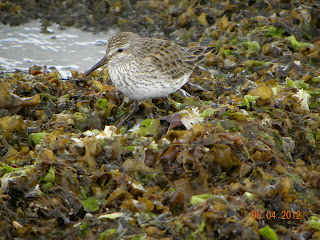A few pictures of a young Harbor Seal hauled up on the beach near Laurel Avenue in Milford on 19 July 2012. Found by a local resident, it was protected by volunteers from Mystic Aquarium. It returned to the Sound the next morning.
Thursday, July 26, 2012
Tuesday, July 24, 2012
Little Yellow, Walnut Beach, 7/24/12
Below a record shot of a Little Yellow at Walnut Beach, first seen yesterday (7/23/12). Today saw at least 3 in windy 90+ heat. Many other butterflies around, almost all nectaring on Spotted Knappweed. My guess is that this colony will be around for at least a few weeks, based on the Little Yellows of 2010 at the same place, same time. Luckily the disturbance of the area for the new boardwalk did not prevent the return of the Spotted Knapweed--and the Little Yellows.
Saturday, July 14, 2012
Silver-bordered Frit, Common Ringlet, mystery 7/14
A few of the butterflies from the CBA walk in East Windsor today: Silver-bordered Fritillary (a dozen seen) and Common Ringlet, 8 seen. Also a mystery Skipper from the yard and a few birds (a Lesser Yellowlegs with a Short-billed Dowitcher, and a Tricolored Heron--one with strange patterns on the flight feathers when it flies from Hammo on 7/13.
Wednesday, July 11, 2012
Baltimore Checkerspot 7/10/12; Sachems, mystery
Tuesday, July 3, 2012
Sachem 7/03/12, 7/05/12
Sachem on Zinnia in yard across street, 5 July 12: This is our earliest Sachem--it first appeared on 3 July 12. This seemed so early for a Sachem that we were hesitant to believe in our ID.
Below a few record shots of what might be a Sachem in our yard on 7/03/12.
A faded Question Mark in the garden on 7/04/12
Below a few record shots of what might be a Sachem in our yard on 7/03/12.
early Fiery Skipper, Variegated Frit July 2012
Thursday, June 28, 2012
Piping Plover 6/28/12 Mfd Pt, juv, female; 6/29 adult
Below a female PIPL at Milford Point spit, probably molting head and body feathers:
Below a short video of the single remaining offspring of the 4 chicks hatched by the PIPL couple that nest most westward on the western extension of the spit. The other 3 chicks were probably lost to an extremely high tide. We saw this bird fly, so he is now a fledgling (or juvenile):
Below a short video of the single remaining offspring of the 4 chicks hatched by the PIPL couple that nest most westward on the western extension of the spit. The other 3 chicks were probably lost to an extremely high tide. We saw this bird fly, so he is now a fledgling (or juvenile):
Two photos of a Spicebush Swallowtail today on our Buddleia. Notice the greenish tint on the doral hindwing--this probably indicates it is a male.
Piping Plover adult from East Broadway 6/29/12 One of two adults tending single chick/juvenile
 |
| Notice wear on coverts |
Tuesday, June 26, 2012
White-rumped SP video
A brief video of one of at least 14 White-rumped Sandpipers at Milford Point on June 7, 2012:
E Bway juveniles 34 days old 6/26/12
Here's a brief video of the 3 East Broadway juveniles (they fledged about 6 days ago) on their 34th day. They've remained at their East Broadway location, usually tended closely by both the male and female adults. Today the adult was tending them as they were resting in the wrack.
Photos of dad and two of the juveniles:
Monday, June 18, 2012
E Bway PIPL 6/18/12
This evening the 3 E Bway chicks, now about 26 days old, were tended by the male only. Here's a brief video of a few chicks and dad:
Monday, June 11, 2012
First wing exercise, E Bway chick 6/11/12
Brief video ending with one of 3 E B'way chicks exercising its wing at 18 days (6/11/12)
Sunday, June 10, 2012
PIPL 2 wks E Bway 6/6/12, Ambush Bug
Thursday, June 7, 2012
More White-rumped SPs, 6/7/12
Monday, June 4, 2012
White-rumped Sandpipers 4 June 12 Mfd Pt
A series of photos and a video of some White-rumped Sandpipers at the Francis St spit of Milford Point on 4 June 12. Birds of North America says this about their migration:
This small Nearctic sandpiper migrates from its principal breeding ground in the Canadian Arctic to the southern extremities of South America, one of the longest animal migrations in the Western Hemisphere. Much of its migration is made in a few, long, non-stop flights, each of which can last as long as 60 hours and transport these birds up to 4,000 kilometers, powered by extensive body fat. Such fat reserves are laid down at key migration staging areas—wetlands where food is especially abundant—making this bird particularly vulnerable to loss of strategic habitat.
This small Nearctic sandpiper migrates from its principal breeding ground in the Canadian Arctic to the southern extremities of South America, one of the longest animal migrations in the Western Hemisphere. Much of its migration is made in a few, long, non-stop flights, each of which can last as long as 60 hours and transport these birds up to 4,000 kilometers, powered by extensive body fat. Such fat reserves are laid down at key migration staging areas—wetlands where food is especially abundant—making this bird particularly vulnerable to loss of strategic habitat.
Subscribe to:
Comments (Atom)





















































